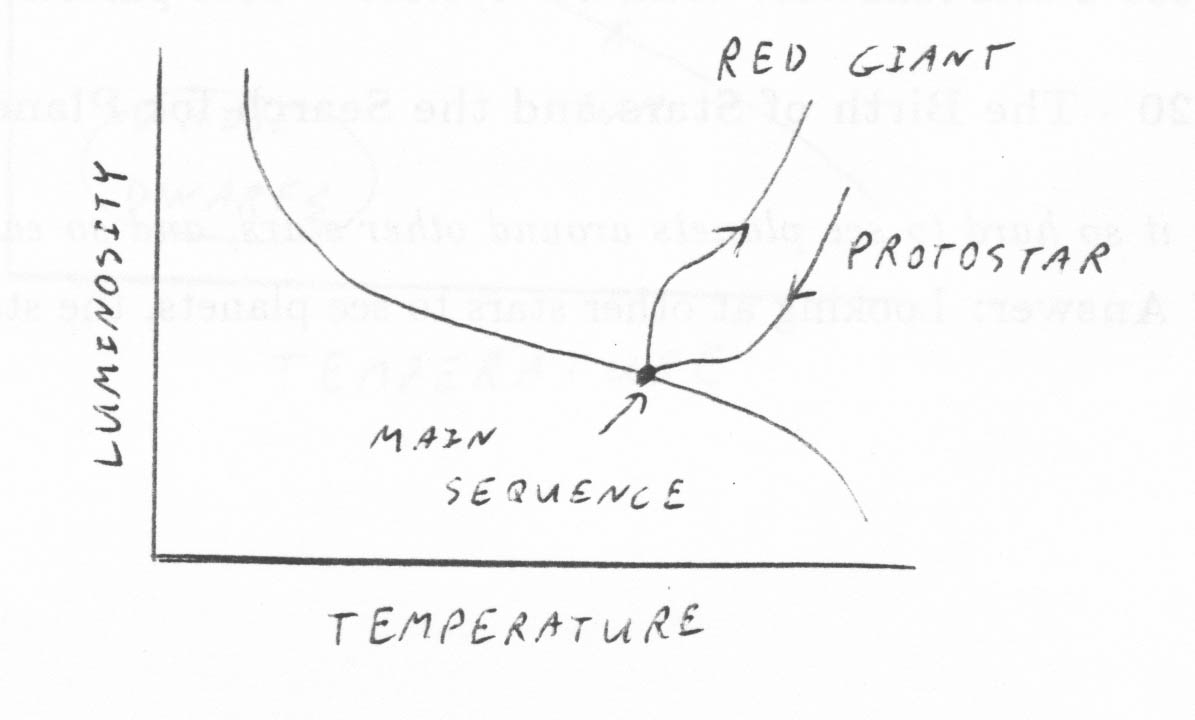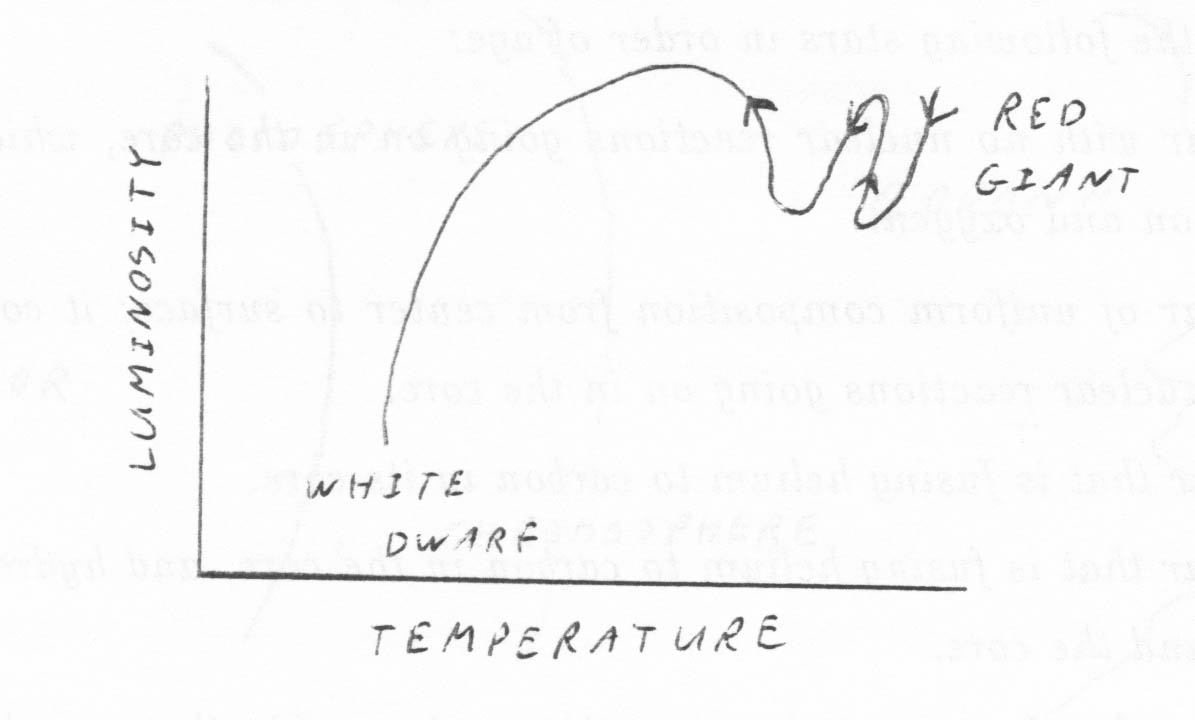
|
ASTRONOMY - Summer 1999
Dr. Robert Gardner Chapters 14-22 Homework Solutions |
Chapter 14 - The Sun: A Garden-Variety Star.
2. Make a sketch of the Sun's atmosphere showing the location
of the photosphere, chromosphere, and corona. What is the approximate
temperature of each of these regions?
Answer: Consider

| Layer | Temperature |
| Photosphere | 4,500 - 6,000 K |
| Chromosphere | 4,500 - 10,000 K |
| Corona | 1,000,000 K |
Chapter 15 - The Sun: A Nuclear Powerhouse.
3. What is the ultimate source of energy that makes the Sun
shine? Answer: The conversion of hydrogen into helium in the
proton-proton chain. During this process, some of the mass of the original
hydrogen (0.7 percent) dissappears and is converted into energy. It is
this energy that eventually leaves the surface of the Sun as sunshine.
Chapter 16 - Analyzing Starlight.
1. What two factors determine how bright a star appears to be
in the sky? Answer: Its intrinsic brightness (or luminosity) and
its distance.
5. What two women astronomers made significant contributions to
the understanding of stellar spectra? Discuss what each of them did.
Answer: Annie Cannon assigned spectral classifications to stars and
ordered the classification system into the system we use today. Cecelia
Payne proved that all stars are mostly composed of hydrogen and that the
differences in their spectra are due to different temperatures.
Chapter 17 - The Stars: A Celestial Census.
6. Sketch an H-R diagram. Label the axes. Show where cool
supergiants, white dwarfs, the Sun, and main-sequence stars are found.

| Star | Apparent Magnitude | Spectrum |
| 1 | 12 | G, main sequence |
| 2 | 8 | K, giant |
| 3 | 12 | K, main sequence |
| 4 | 15 | O, main sequence |
| 5 | 5 | M, main sequence |
Chapter 18 - Celestial Distances.
17. Give the distances to stars having the following
parallaxes:
a. 0.1 arcsec. Answer: The relationship between distance
d (in parsecs) and parallax p (in arcseconds) is
d=1/p. Therefore d = 1/0.1 = 10 parsecs.
b. 0.5 arcsec Answer: Well, d = 1/0.5 = 2
parsecs.
c. 0.005 arcsec Answer: Well, d = 1/0.005 =
200 parsecs.
d. 0.001 arcsec Answer: Well, d = 1/0.001 =
1000 parsecs.
Chapter 20 - The Birth of Stars and the Search for Planets.
5. Why is it so hard to see planets around other stars, and so
easy to see them around your own? Answer: Looking at other stars to
see planets, the star is so much brighter than the planets that they get
lost in the glare. Seeing planets around our Sun is easy because we don't
have to look towards the Sun to see them (and they are often not in the
Sun's glare), and most of them appear bright in the sky.
6. What techniques have been used to search for planets around
other stars? Answer: The motion of the stars as the planet moves
around it has been measured in two different ways. The motion may produce
movements of the star in the plane of the sky (movement detected by the
wooble of the star's proper motion). It may also produce a radial motion
which can be detected by the Doppler shifts in spectroscopic lines.
Chapter 21 - Stars: From Adolescence to Old Age.
2. What is the main factor that determines where a star
falls along the main sequence? Answer: Its mass.
4. Describe the evolution of a star with a mass similar to that
of the Sun, from the protostar stage to the time it becomes a red giant.
First give the description in words and then sketch the evolution on an H-R
diagram. Answer: In the protostar stage, it is a dense cloud of gas
that is contracting due to its own gravity. As it contracts, it heats up.
What light it gives off is from this heat. Once the center of the
protostar besomes hot enough, hydrogen fusion begins. This marks the start
of being a main sequence star. It also stops collapsing at this point,
reaching a balance between gravity pulling in and energy pushing out
(hydrostatic equilibrium). When the core of the star has completely
used up all of the hydrogen, fusion stops and the star begins collapsing
again, causing the center to get hotter. A region around the core becomes
hot enough for hydrogen fusion (in a shell of hydrogen around the core).
The energy from these reactions produces an outward force and the star gets
very large. This is an orange giant. The core continues to collapse and
get hotter, until it is hot enough for helium to be fused into carbon.
Once helium fusion begins, it is a red giant. The energy from the helium
fusion stops the contraction and produces more outward pressure, making the
star much larger.


Chapter 22 - The Death of Stars.
1. How does a white dwarf differ from a neutron star?
Answer: A white dwarf differs from a neutron star in composition and in
size. White dwarfs are composed mostly of carbon, while neutron stars are
simply a giant ball of neutrons. White dwarfs are about the size of Earth,
while neutron stars are about the size of a city.
How does each one form? Answer: White dwarfs form after
a low mass red giant (under 1.4 solar masses at the end of its
main-sequence life) has used all its helium in the core. The core
collapses under its own weight, but never gets hot enough for further
fusion (since it is small). A neutron star forms when a star of mass
greater than 1.4 solar masses (and less than 3 solar masses) exhausts its
nuclear fuel and the core collapses. The collapse is hautled when a
core of neutrons is produced. The abrupt end of the contraction produces
shock waves outside the core which blow the outer layers off of the star
in a supernova.
What keeps each from collapsing under its own weight?
Answer:
White dwarfs don't collapse due to "electron degeneracy pressure," which
means that the electrons in the atoms push against each other. The
electrons can only be so close together. Neutron stars don't collapse due
to the "Pauli Exclusion Principle" which prevents two particles from being
in the same place and having the same energy at the same time. This means
that the neutrons can only get so close together.
10. Arrange the following stars in order of age:
a. A star with no nuclear reactions going on in the core, which
is made primarily of carbon and oxygen.
b. A star of uniform composition from center to surface; it
contains hydrogen but has no nuclear reactions going on in the
core.
c. A star that is fusing helium to carbon in its core.
d. A star that is fusing helium to carbon in the core, and
hydrogen to helium in a shell around the core.
e. A star that has no nuclear reactions going on in the core,
but is fusing hydrogen to form helium in a shell around the core.
Answer: Youngest to oldest: Star b (uniform composition and no
nuclear reactions means that it is a protostar), Star c (hydrogen fused into
helium in the core means it is a main sequence star), Star e (hydrogen
fusion in a shell around a dormant core means it is an orange giant), Star
d (helium fusion in the core and hydrogen fusion in the shell means it is a
red giant), Star a (a core entirely of carbon and oxygen means that it is
at then end of the red giant stage).
Return to Bob Gardner's NSTCC astronomy homepage.